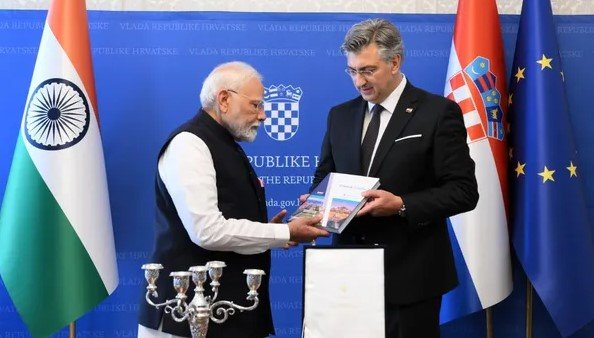Prime Minister Narendra Modi’s brief stopover in Croatia may have lasted just a day, but the echoes of his visit could shape bilateral ties for years to come. From deep conversations on trade and defence to shared smiles during a city walk, Modi’s interaction with Croatian PM Andrej Plenković turned out to be more than just a diplomatic pit stop.
‘Felt at Home’: Modi’s Sentiment Speaks Volumes
Stepping into the heart of Zagreb on a breezy June afternoon, PM Modi appeared more like a familiar guest than a foreign dignitary.
“I felt at home,” he said, a phrase that didn’t just reflect his emotional tone but signalled the comfort level between the two countries. It was a brief visit, yes, but one packed with layers of warmth, symbolism, and substance.
As he strolled with PM Plenković through the city’s central square — with its Baroque buildings, cobbled streets, and soft evening light — locals paused to wave, snap photos, and, in some cases, cheer. This wasn’t just protocol. It felt genuinely welcoming.
And that’s exactly what both sides seemed to want — a bond that’s real, not just rehearsed.

From Culture to Commerce: A Range of Strategic Conversations
At the core of their meeting were key topics that have long simmered beneath the surface of diplomatic briefs — trade, defence, and technology.
Officials from India’s Ministry of External Affairs confirmed that talks went beyond pleasantries. The two prime ministers dug into actionable areas:
-
Boosting trade volumes in pharmaceuticals, IT, and green energy
-
Defence partnerships focused on tech transfer and manufacturing
-
Digital cooperation, including AI and cybersecurity
Modi was clear. India isn’t just looking west; it’s looking for meaningful, agile partners. And Croatia, though small in size, sits strategically inside the EU, making it a vital gateway for Indian businesses eyeing the European market.
Plenković, for his part, called the talks “constructive and energising.”
Soft Power is Hard Influence: Yoga, Indology, and the Indian Connection
You can’t talk India without talking culture. And this visit made that point again.
Even before the formal talks began, Croatia had already seen a cultural wave from India: Yoga, Indian classical music, and a growing interest in Indology.
According to MEA sources, both leaders emphasised how these cultural bridges — from Sanskrit studies to yoga studios — are soft-power tools that are helping people-to-people ties flourish.
It’s more than symbolic.
-
Croatian universities now offer Sanskrit and Indian philosophy courses
-
Zagreb hosts an annual International Yoga Day celebration
-
Bollywood films and Indian cuisine are finding larger local audiences
Modi reportedly told Plenković that culture is a two-way street. “It’s not just about what India brings. It’s about what we learn from you too.”
Why Croatia Matters More Than You Think
Well, here’s the thing. Croatia may not be the biggest player in Europe, but it’s got influence. It’s in the EU, it has a Mediterranean coastline, and its geopolitical positioning gives it a vantage point that countries like India care about.
And there’s another angle — defence.
India is keen on diversifying its defence partnerships, and Croatia, with its naval shipyards and growing aerospace tech sector, could be a sleeper partner in that effort.
Plus, both nations are aligned on global issues like climate action, multilateralism, and a free Indo-Pacific. This alignment was echoed in their joint statements after the meeting.
A Short Visit, But Not a Small One
Let’s not sugarcoat it — the visit was quick. Modi didn’t spend days in Croatia. There were no long processions, no elaborate galas. But sometimes, the most impactful conversations don’t need a red carpet.
This was one of those times.
In the span of hours, the two prime ministers managed to not only check off several strategic boxes but also convey genuine goodwill. That matters. Especially now, when so many global relationships feel like they’re hanging by threads.
Their walk through Zagreb, the warm exchanges on X (formerly Twitter), the nods to culture and community — they weren’t just PR. They set the tone for a future that’s equal parts practical and personal.
